Beijing Airport splits traffic: Hong Kong, Seoul, Shanghai race to be Asia's 100 million pax airport
Slower than expected reform of airspace and movement growth at Beijing Capital airport has meant that Asia's largest airport has not, as forecast, overtaken Atlanta Hartsfield-Jackson as the world's largest airport. A growth streak in 2015 allowed Atlanta to become the world's first airport to handle over 100 million passengers a year. The future largest airports are expected to be in Istanbul and Dubai, but with those projects some time away from full implementation the next airport to cross the 100 million mark may come from Asia.
If Beijing Capital's growth of recent years continues it could cross the 100 million mark in 2019 - but in that year the opening of the city's second international airport, Beijing Daxing, is expected. China has made official its plan for China Eastern and China Southern and their partners to move to Daxing, while Air China and its partners remain at Capital. The split means that Beijing Capital may not cross the 100 million mark in the near future. Even if growth accelerates, Beijing will hold the title only briefly.
Recent weeks have seen spurts of capacity growth. Tokyo has finalised plans to increase Haneda capacity in preparation for the 2020 Tokyo Olympics, while Hong Kong has started construction of its third runway. Other Asian hubs - Guangzhou, Seoul Incheon, Shanghai Pudong, Singapore Changi - could put through 100 million passengers towards the late 2020s to 2030s. 100 million passenger airports will test airport management and strengthen the need for airport-airline partnerships.
Evolution of total passenger throughput (in millions) at the 10 largest airports in Asia: 2008-2015
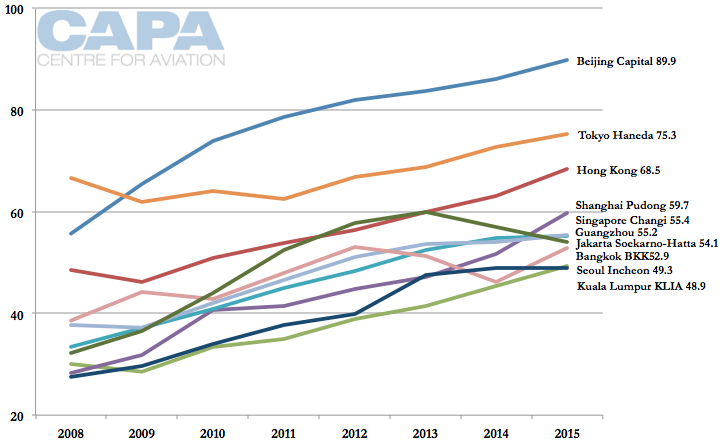
For some of Asia's 10 largest airports in 2015 100 million annual passengers was a distant target - not in terms of demand but of available infrastructure. As strained as other hubs may be, there is no substantial expansion plan for Jakarta Soekarno-Hatta and Bangkok Suvarnabhumi.
Forecasting the future is difficult. Nowhere is that more true than in air traffic growth. Increases depend on infrastructure, with terminals and runways taking different amounts of time to construct based on location and politics. Not all growth has to be tied to GDP and other correlations. Lack of airport infrastructure and airline market power may dampen a forecast over the long term, while available capacity and recognition can accelerate growth.
All of this can change in a few years, often due to management and political will. Some forecasts made earlier this decade are well off track already. This report seeks to identify planned developments and what potential there is.
Gap between Beijing and Atlanta airports widening after years of narrowing
2015 was the first year in recent history when the gap between Beijing Capital and Atlanta Hartsfield-Jackson airports widened. Previously Beijing Capital had been narrowing the gap as it grew, while Atlanta experienced more moderate growth. In 2014 the gap between the two was only 10.1 million passengers, but in 2015 it widened to 11.6 million (although this puts the gap back to 2012/2013 levels).
Atlanta's traffic was flat between 2007 and 2010 but then expanded by 12 million passengers between 2010 and 2015, with the growth largely weighted to 2015. Between 2010 and 2014 Atlanta added 6.9 million passengers. In 2015 alone it added 5.3 million - more than the 3.8 million that Beijing Capital added.
Atlanta's 2015 passenger growth of 5.5% was largely driven by Delta, which grew slightly faster at 6.0%. Atlanta is Delta's home and Delta is the largest airline at Atlanta. Together with its branded affiliates Delta accounts for 80% of passengers at Atlanta, meaning that Delta puts through more passengers at Atlanta than any other airport (except Beijing) has total passengers.
Beijing Capital had two blockbuster years of growth due to infrastructure improvements, adding 9.4 million passengers in 2009 and then 8.6 million in 2010. That began to max out capability, and growth tapered. Beijing Capital's additional 3.8 million passengers in 2015 represented the largest net volume increase since 2011's 4.7 million additional passengers. Beijing Capital crossed the 50 million passenger threshold in 2007.
Previous forecasts for Beijing to overtake Atlanta appear to have been ambitious, relying on an expected growth surge despite airport capacity dwindling and local operators being pessimistic about growth opportunities. Atlanta's 1H2016 growth is 4.5%, placing it on track for another strong year - and another year of growth that will make it hard for Beijing Capital to exceed. Even if Atlanta's growth were more subdued and remained as such for the rest of the decade, it is unlikely that Beijing Capital would exceed Atlanta before a restructure significantly changes the airport landscape in China's capital.
Atlanta Hartsfield-Jackson and Beijing Capital airports annual passenger system traffic, and annual difference between them (in grey): 2007-2015
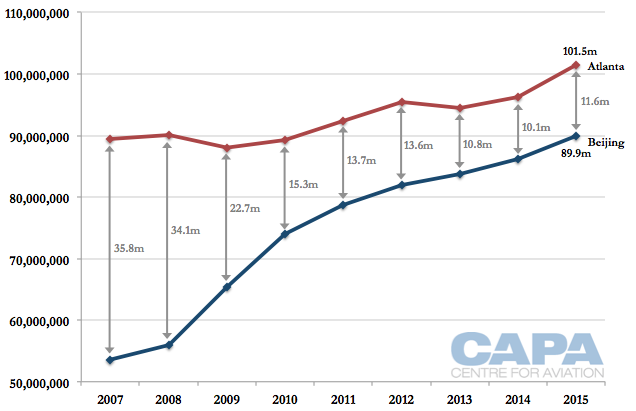
Beijing to split traffic in 2019 with opening of a second major airport
Beijing is preparing to open its second major international airport, Beijing Daxing, in 2019. Once completed the airport will have capacity to handle 45 million passengers p/a and 70 million passengers by 2025 (Capital's capacity is 85 million, which is being exceeded). The opening of Daxing will result in Beijing's current second airport - Beijing Nanyuan - closing to commercial aircraft. Nanyuan is only used by China United Airlines, the subsidiary of China Eastern that has been converted to a LCC. The plan has always been for Beijing Daxing to complement Beijing Capital and not to replace Beijing Capital.
In Jul-2016 China confirmed a long-running concept of how airlines and their traffic would be split in Beijing: Air China and its Star Alliance partners (and presumably others, like Cathay Pacific) would remain at Beijing Capital. China Eastern, China Southern and other SkyTeam airlines will move to Beijing Daxing. Hebei Airlines, Beijing Capital Airlines and China Postal Airlines will also move to Beijing Daxing.
The official circular did not mention Hainan Airlines, the fourth largest airline for system traffic and second largest for international. Hainan's infrastructure at Beijing Capital is old, and split between terminals for domestic and international flights. There would be pressure from Air China to limit Hainan's improvements.
In 2008 Air China and others moved into terminal three, the Fosters and Partners terminal that was the largest until Dubai's terminal three. Beijing Capital's terminal three is the single terminal for Air China. Since the opening there have been additional investments, ranging from a lounge to more gates. So Air China was not interested in moving its largest operation (or nearby corporate offices). Ground infrastructure is to be determined: Capital is closer to the city centre but Daxing has been approved for a high-speed rail project. The airports will be in opposite directions, and Daxing is positioned as a hub for the larger surrounding area.
The splitting of Air China and China Southern gives doubt to rumours that the two would be merged. Some observers say that scenario was effectively a ploy to encourage the airlines to compromise over future operations at Beijing.
The favourable terms allow China Eastern, China Southern and others to move over a four-year period. Provided Daxing's infrastructure is ready, they will probably prefer to condense the move period so that their hub is not split (with resulting complication and confusion). China Southern, primarily based at Guangzhou, will base 100 aircraft at Daxing in 2019, building to 150 aircraft in 2025. China Southern expects to be able to operate A380s on trunk routes that Air China flies from Beijing Capital. One unexpected element is that China Eastern has also been named a base airline at Daxing - presumably allowing it favourable traffic rights as well.
The impact is that Beijing Capital's traffic will initially experience a significant reduction - even perhaps a halving, although this depends how quickly Air China backfills capacity. Total traffic for airports in Beijing will grow. Moving airlines from Capital gives them growth at Daxing and allows Air China and partners to grow over the coming decade. It is unclear so far how air traffic will be organised to accommodate both hubs, but the moving of flights eliminates one air traffic bottleneck.
China Eastern and China Southern (including Xiamen Airlines) account for approximately 29% of system seat capacity at Beijing Capital in Aug-2016. Air China and Shenzhen Airlines account for approximately 40%.
Beijing Capital Airport system seat capacity share by airline: 1-Aug-2016 to 7-Aug-2016
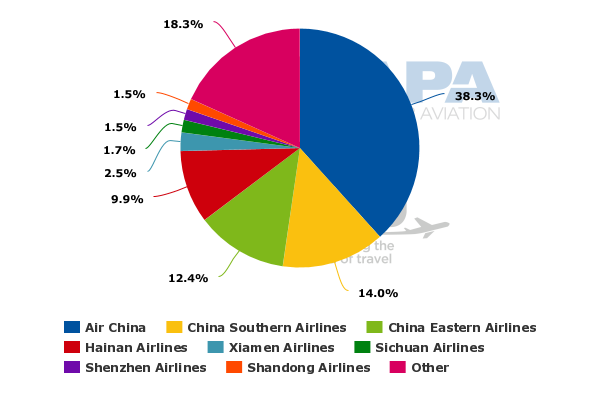
Overall, Star Alliance accounts for 45% of system seat capacity at Beijing Capital while SkyTeam accounts for 32%. oneworld, without a mainland Chinese member, accounts for 3%.
Beijing Capital Airport system seat capacity share by alliance: 1-Aug-2016 to 7-Aug-2016
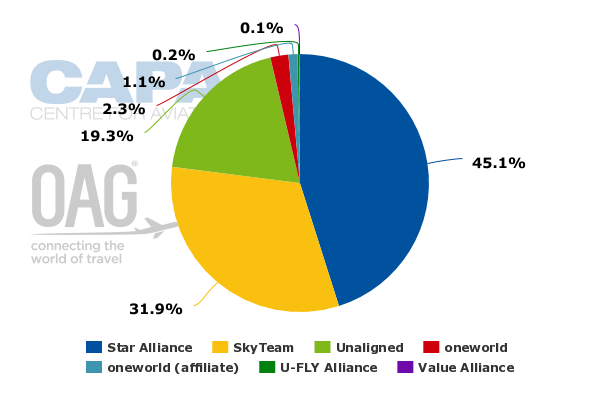
Dubai and Istanbul plan for long term hubs
Dubai and Istanbul are expected to be among the world's largest hubs in the medium/long term, with Dubai the largest. But these visions are some time away from being fully realised. Turkish authorities expect the new Istanbul Grand Airport to open in 2018 with capacity for 90 million passengers per annum, although initially 70 million passengers per annum will use it. By 2028 the design capacity will be 150 million.
Emirates does not intend to move from Dubai International to its new hub at Dubai World until the latter can accommodate its existing operation in its entirety. With approximately 80% of Emirates traffic connecting, splitting flights across a hub is not practical. Passenger throughput in Dubai will increase as flydubai - the second largest operator and holder of slots at Dubai International - moves to Dubai World in 2017.
flydubai's exit will permit Emirates and others to grow at Dubai International - which has nearly reached saturation and in fact has already done so at peak hours - which is what Emirates thrives on as a connecting airline. Air traffic improvements can incrementally increase slots.
While Emirates may grow at Dubai International, the airport's growth has started to plateau. While traffic across Dubai airports will surpass 100 million passengers, Dubai will not have a single 100-million-passenger airport until Dubai World is ready for Emirates.
See related report: flydubai begins dual-hub strategy with Dubai World Central launch. Emirates still silent on DWC move
Tokyo Haneda to increase international slots by 65%
Japan has followed through with its intent to increase capacity at Tokyo Haneda airport in time for the 2020 Olympic Games in Tokyo. An exact implementation date has not been given. Daytime international slots will increase by 39,000 slots per annum from 60,000 slots p/a (82 daily slot pairs) to 99,000 p/a (166 daily slot pairs) - a 65% increase.
International slots are typically evenly allocated between Japanese and foreign airlines. Night-time international slots remain unchanged at 30,000 slots p/a.
However as Haneda is mostly a domestic airport, the slot increase equates to an approximately 9% overall increase for the airport. Japan expects that foreigners will account for 42% of the additional throughput - or 2.94 million additional passengers out of 7.05 million total additional passengers.
Tokyo Haneda Airport annual system passenger numbers: 2008-5M2016
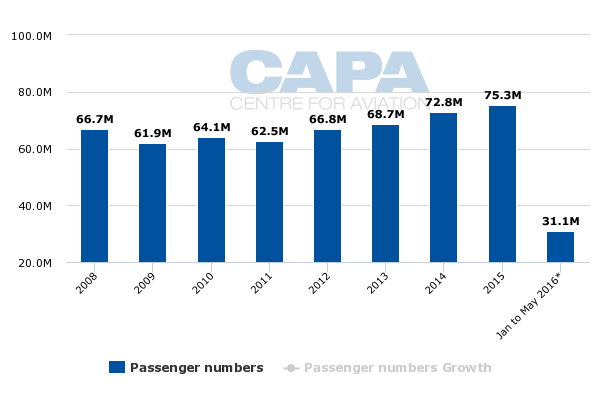
The exclusive distribution of slots to international flights coincides with Japan's international tourism push. Japan received just under 20 million visitors in 2015 and forecasts 40 million for 2020, a doubling of a target set only a few years prior. Japan's domestic traffic has low to no growth projections over the medium term.
To reach 40 million, Japan will need to expand airport infrastructure across the country.
See related report: Japan tourism targets doubled, despite airline capacity decreases. Long haul focus
Japan visitor arrival development: 1990-2030F
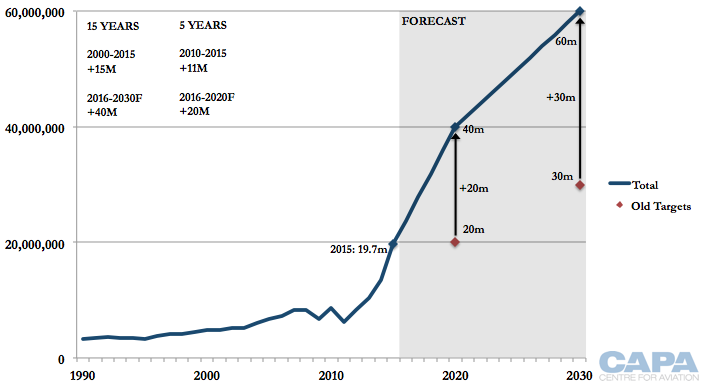
The approximately 7 million additional passengers will be added to Haneda's 2015 passenger throughput of 75.3 million, which includes 12.7 million international passengers in 2015. Passenger growth will be incremental until the slot increase: domestic growth can occur through upgauging and load factor improvements, but passenger growth in recent years has hovered around 1-2%.
International will increase following marginal new flights as a result of the US-Japan agreement on daytime international slots, which produced one new slot for each side (but moved night-time slots to daytime slots). International growth will also occur with the utilisation of vacant night-time slots.
LCCs are starting to offer Haneda flights during night/early morning hours. Some foreign airlines would like to add night/early morning flights but have reached the allocation, despite the slots being available.
Tokyo Haneda Airport annual international passenger numbers: 2008-5M2016
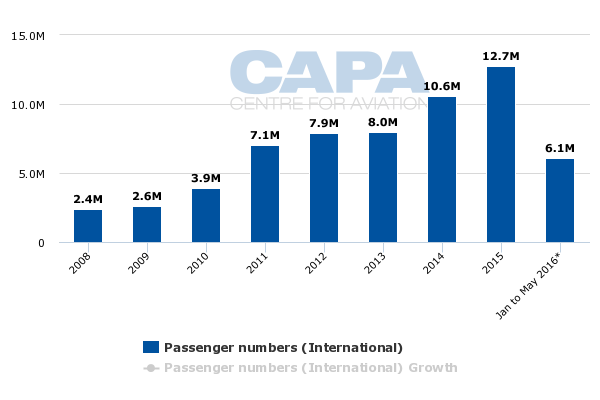
The additional Haneda slots are being created as a result of improved air traffic flow around Tokyo. (There will need to be changes to taxiways and other infrastructure at Haneda, but nothing significant - such as a new runway.)
Flights were previously routed over Tokyo Bay and away from urban areas but will now be able to fly over major parts of Tokyo, including Shibuya and Shinjuku, for example. A Jul-2016 agreement was announced between Japan's MLIT and Tokyo's wards (districts). There have been exceptional concerns about noise levels over the city, which can be extremely low away from major areas. Politicians have been careful not to antagonise constituents.
Overall the increase is merely the start of what Tokyo Haneda could apply as an increase under an ideal scenario. The airport operates with four runways, but complex routings mean that Haneda has one of the lowest ratios of movements per runway among major airports.
Tokyo expects a further slot increase will only be possible with a fifth runway which, like the fourth, will need to be built in Tokyo Bay.
Haneda, like other airports, could have already reached 100 million annual passengers if infrastructure had been optimised. Haneda passengers could exceed 85 million in 2020. Reaching 100 million passengers - possibly before any other airport in the world - will depend on how quickly Tokyo proceeds with the fifth runway and whether airspace can be further optimised, which itself depends on more agreements with local residents. In 3.5 years Haneda has reclaimed land and constructed its fourth runway (runway D) in Tokyo Bay.
Tokyo must balance international growth at Haneda with the concerns of Tokyo Narita: Narita was formerly Tokyo's international hub but flights have shifted from Narita to Haneda as slots have become available. Narita has gained replacement international flights - notably from ANA and JAL as they look to boosting Narita as a sixth freedom hub to/from North America.
Narita has also shifted to domestic flights, and in particular catering to Japan's new low cost segment - having now constructed a dedicated LCCT, terminal 3. Previously, domestic traffic at Narita was minimal.
See related reports:
- Tokyo Narita Outlook Part 1: once a mega hub, international and transit passengers decline
- Tokyo Narita Part 2: low cost terminal opening underlines airport's short haul low cost evolution
Annual traffic comparison for Tokyo Haneda Airport and Tokyo Narita Airport: 2008-5M2016
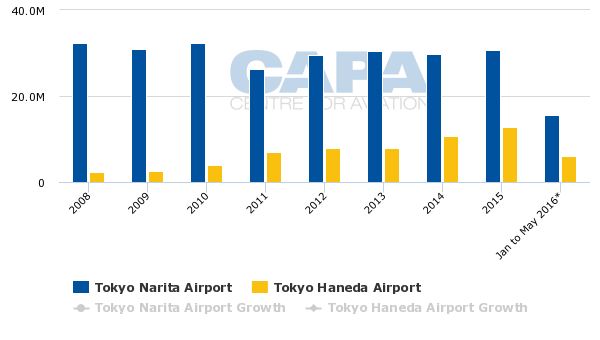
Hong Kong starts third runway construction to boost capacity to 100 million by 2030
On 01-Aug-2016 Hong Kong ceremoniously marked the start of its eight-year "three runway system" (3RS) project and the third runway is expected to be operational in 2022. Because of other works Hong Kong will not be able to use all three runways until 2024; these works include a new terminal with 57 parking positions, taxiways, expansion for departure/arrival formalities at terminal two, a passenger train shuttle and baggage system, and maintenance works to the existing runways.
Some believe that this two year period between the third runway opening and all three runways being put in use has intentionally been given as significant buffer room, in the event of delays. Airport Authority Hong Kong calls 3RS tantamount to building a new airport; after all, it is much more than just another runway. AAHK estimates that the project will reclaim 650 hectares of land.
Hong Kong's third runway comes significantly late. Hong Kong, like Singapore, did not forecast the growing use of narrowbody aircraft and the rise in LCCs. These factors are broadly but not exclusively correlated. Movement growth outpaced passenger throughput, requiring expansion plans to be accelerated. The approval process in Hong Kong was dragged out and characterised by contention.
Hong Kong appeared to show interest in different opinions, perhaps to make up for it largely ignoring opinions when it rushed to replace Kai Tak before the 1997 handover.
Airlines and IATA also disagreed on the funding for the project, with those parties wanting it funded through airport profits (Hong Kong can be measured as one of the world's most profitable airport, or the most profitable airport), or through loans that could be made at very low rates. In the event, passenger charges were increased. The biggest winner (or smallest loser, depending on the view) is Cathay Pacific as transit passengers will pay lower fees than Hong Kong departing passengers. Other airlines' departing Hong Kong passengers will essentially subsidise Cathay's transfer network.
Even upon completion and full operation, problems will not disappear. For a few years Hong Kong Airport has been saturated during most of the day, and evening through to midnight (a popular departure time for long haul flights, mainly to Europe). A switch in air traffic control technology in Oct-2016 will permit movement growth and there are expectations that there will be further slot growth in coming years. However, this is all expected to be incremental rather than transformational. Demand will remain significantly below capacity. Thus the additional runway capacity in 2024 comes not to cater for a decade of future growth but to accommodate a decade of unrealised growth.
It took Hong Kong six years to add 10 million passengers and grow from 30 million to 40 million.
The next 10 million took five years (reaching 50 million), the next 10 million four years (reaching 60 million) and then the next 10 million will take two years (reaching 70 million in 2016). Even if volume passenger growth slows, there will be a substantial backlog of unrealised growth by the time all three runways are in operation. It is not difficult to see Hong Kong reaching 102 million passengers ahead of the 2030 forecast.
Hong Kong will need a fourth runway. Or, given the limited amount of space there remains to reclaim in Hong Kong territory around the current airport site Hong Kong must utilise all three runways until 2024 - an all-new airport. The lead time and guaranteed debate mean that this needs to be planned almost immediately if capacity is to remain ahead of demand. However, there is no political will to do so; it is Hong Kong style to make changes incrementally and not in quick succession. Although it was obvious that Chek Lap Kok would need more than one runway if it was to provide substantial growth opportunities over Kai Tak (which had one runway), Chek Lap Kok was not initially approved with two runways.
An upcoming CAPA report will focus on the future of the Hong Kong aviation hub.
Seoul Incheon, Singapore, Guangzhou and Shanghai Pudong also look to 100 million
Seoul Incheon, like Hong Kong, plans to reach approximately 100 million annual passengers in 2030. As with Hong Kong, this may be too conservative. As CAPA has previously written:
On average, Incheon will need to add 3.3 million passengers every year through to 2030 in order to reach 100 million. This is slower than growth in recent years: in 2015 Incheon added 3.7 million passengers; in 2014 - 4.0 million passengers; and in 2013 - 2.5 million additional passengers.
Incheon's 2030 target could be too conservative. Adding 4 million passengers per annum could mean that Incheon reaches 100 million passengers in 2028, two years ahead of schedule.
Seoul Incheon airport annual additional passengers (left axis) and total throughput (right axis): 2003-2030F
See related report: Seoul Incheon airport: 49 million passengers in 15 years. Well on the way to 100 million in 2030
Well-known Singapore Changi ended 2015 with 55 million passengers, the same as Guangzhou Baiyun. In 2013 Changi decided to move ahead with plans to open a third runway to commercial service in 2020. However, Changi has regularly been turning airlines away due to slot constraints. Changi's current four terminals will be able to handle 85 million annual passengers, slots permitting. A future fifth terminal will bring substantial capacity growth, possibly doubling capacity.
See related report: Singapore Changi ensures its future as leading ASEAN hub with third runway and fifth terminal
Singapore Changi annual passenger capacity by terminal
|
Terminal |
Current capacity |
Future capacity |
Gates |
Year opened |
|---|---|---|---|---|
| T1 | 21,000,000 |
24,000,000 |
29 |
1981 |
| T2 | 23,000,000 |
23,000,000 |
35 |
1990 |
| T3 | 22,000,000 |
22,000,000 |
28 |
2008 |
| T4 | N/A |
16,000,000 |
TBD |
2017* |
| Total | 66,000,000 |
85,000,000 |
|
|
Guangzhou Baiyun has opened a third runway but its capacity has not been utilised: movements actually decreased year-on-year. A second terminal will boost design capacity to 80 million passengers later this decade. There were questions about how much larger Baiyun would get: China's central planning arm is investigating a second airport for Guangzhou while the airport's chairman has reportedly cautioned that airports stop becoming efficient through scale after 80 million or 100 million passengers.
Baiyun's most recent public plans are to have five runways (currently: two) and three terminals (currently: one, with another under construction), handling 100 million passengers a year.
Shanghai Pudong is constructing what it calls the world's largest satellite terminal. Compared with the combined size of terminals one and two the satellite terminal will have more gates (83 to the existing 70). It will be able to handle 38 million passengers when completed in 2019. Pudong projects 80 million passengers in 2025. Shanghai Pudong carried 60 million passengers in 2015 and 32 million (10.5% growth) in 1H2016. New flights are regularly being turned away - often due to protectionism, as is common. Between 2013 and 2016 Pudong will have added over 15 million passengers, so an 80 million projection for 2025 appears extremely conservative.
Beyond the satellite terminal, future Shanghai capacity may involve a third Shanghai area airport (there is also the domestic-focused Hongqiao). The third airport may be positioned as low cost airport (and be some distance from Shanghai - further than even Pudong), although Spring and other operators will surely fight a move and are already working with Shanghai Airport Authority to stress how low cost passengers are as efficient and profitable as other passengers, or even better.
Outlook: how to cope with an airport throughput of 100 million passengers
After 100 years of aviation history, it was not until 2015 that a single airport transported more than 100 million passengers a year. In 2010 there were 11 airports carrying over 50 million annual passengers, according to ACI. In 2000 there were only six such airports. These singular massive hubs are entering uncharted territory. The next 100 million annual passenger airports will be different from the first.
Whereas Atlanta is mostly a domestic airport the next ones are heavily international, with notable international connecting traffic.
It may not be dissimilar to driving, where the difference between 90 miles an hour and 100 is noticeable and - for reasons outside the control of the driver (airport management) - can go wrong. Yet airports have proven adept at making the transition from 50 million to 100 million annual passengers. Where there are significant challenges, it is usually not the infrastructure and processes but the timeliness of that support and expansion. And some airports plan to go well beyond 100 million.
These new mega-airports will foster new ways of management and stress the need for continuity. Airport management, often government appointments or heavily government influences, can be a revolving door. At airlines it is rare for an "outsider" to come in as CEO. This infrequency is not always for the good, but there is balance to be found between airline and airport management.
As is increasingly being made evident, the best outcomes for airports and airlines are through partnerships, which in turn work best where there is consistent meeting of minds.
